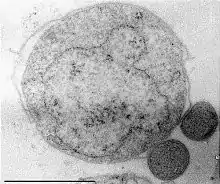Ignicoccus
Ignicoccus is a genus of hyperthermophillic Archaea living in marine hydrothermal vents. They were discovered in samples taken at the Kolbeinsey Ridge north of Iceland, as well as at the East Pacific Rise (at 9 degrees N, 104 degrees W) in 2000.[1]
| Ignicoccus | |
|---|---|
 | |
| Ignicoccus hospitalis (with two smaller, symbiotic Nanoarchaeum equitans) | |
| Scientific classification | |
| Domain: | |
| Phylum: | |
| Class: | |
| Order: | |
| Family: | |
| Genus: | Ignicoccus Huber, Burggraf, Mayer, Wyschkony, Rachel & Stetter 2000 |
| Type species | |
| Ignicoccus islandicus Huber & Stetter 2000 | |
| Species | |
| |
Systematics
According to the comparisons of 16S rRNA genes, Ignicoccus represents a new, deeply branching lineage within the family of the Desulfurococcaceae.[2] Three species are known: I. islandicus,[1] I. pacificus[1] and I. hospitalis strain KIN4I.[3]
Cell structure
The archaea of the genus Ignicoccus have tiny coccoid cells with a diameter of about 2 µm, that exhibit a smooth surface, an outer membrane and no S-layer.[4]
They have a previously unknown cell envelope structure—a cytoplasmic membrane, a periplasmic space (with a variable width of 20 to 400 nm, containing membrane-bound vesicles), and an outer membrane (approximately 10 nm wide, resembling the outer membrane of gram-negative bacteria). The latter contains numerous tightly, irregularly packed single particles (about 8 nm in diameter) and pores with a diameter of 24 nm, surrounded by tiny particles, arranged in a ring (with a diameter of 130 nm) and clusters of up to eight particles 12 nm in diameter each.[4]
The two layers of membrane previously reported are actually a type of endomembrane system consisting of cytoplasmic protrusions. In I. hospitalis, these structures harbor the endosymbiotic archaeon Nanoarchaeum equitans.[3]
Physiology
Ignicocci live in a temperature range of 70–98 °C (optimum around 90 °C). They gain energy by reduction of elemental sulfur to hydrogen sulfide using molecular hydrogen as the electron donor.[2] A unique symbiosis with (or parasitism by) Nanoarchaeum equitans has also been reported.[2]
Phylogeny
| 16S rRNA-based LTP_12_2021 by The All-Species Living Tree Project.[5][6][7] | GTDB 07-RS207 by Genome Taxonomy Database.[8][9][10] | ||||||||||||||||||||||||
|---|---|---|---|---|---|---|---|---|---|---|---|---|---|---|---|---|---|---|---|---|---|---|---|---|---|
|
|
References
- Huber H, Burggraf S, Mayer T, Rachel R, Stetter KO (November 2000). "Ignicoccus gen. nov., a novel genus of hyperthermophilic, chemolithoautotrophic Archaea, represented by two new species, Ignicoccus islandicus sp nov and Ignicoccus pacificus sp nov. and Ignicoccus pacificus sp. nov". International Journal of Systematic and Evolutionary Microbiology. 50 (6): 2093–2100. doi:10.1099/00207713-50-6-2093. PMID 11155984.
- Huber H, Hohn MJ, Rachel R, Fuchs T, Wimmer VC, Stetter KO (2 May 2002). "A new phylum of Archaea represented by a nanosized hyperthermophilic symbiont". Nature. 417 (6884): 63–67. Bibcode:2002Natur.417...63H. doi:10.1038/417063a. PMID 11986665. S2CID 4395094.
- Heimerl T, Flechsler J, Pickl C, Heinz V, Salecker B, Zweck J, Wanner G, Geimer S, Samson RY, Bell SD, Huber H, Wirth R, Wurch L, Podar M, Rachel R (13 June 2017). "A Complex Endomembrane System in the Archaeon Ignicoccus hospitalis Tapped by Nanoarchaeum equitans". Frontiers in Microbiology. 8: 1072. doi:10.3389/fmicb.2017.01072. PMC 5468417. PMID 28659892.
- Rachel R, Wyschkony I, Riehl S, Huber H (March 2002). "The ultrastructure of Ignicoccus: evidence for a novel outer membrane and for intracellular vesicle budding in an archaeon". Archaea. 1 (1): 9–18. doi:10.1155/2002/307480. PMC 685547. PMID 15803654.
- "The LTP". Retrieved 23 February 2021.
- "LTP_all tree in newick format". Retrieved 23 February 2021.
- "LTP_12_2021 Release Notes" (PDF). Retrieved 23 February 2021.
- "GTDB release 07-RS207". Genome Taxonomy Database. Retrieved 20 June 2022.
- "ar53_r207.sp_label". Genome Taxonomy Database. Retrieved 20 June 2022.
- "Taxon History". Genome Taxonomy Database. Retrieved 20 June 2022.
Further reading
- Huber H, Kueper U, Daxer S, Rachel R (August 2012). "The unusual cell biology of the hyperthermophilic Crenarchaeon Ignicoccus hospitalis". Antonie van Leeuwenhoek. 102 (2): 203–219. doi:10.1007/s10482-012-9748-5. PMID 22653377. S2CID 7732441.
- Nass B, Poll U, Langer JD, Kreuter L, Kuper U, Flechsler J, Heimer T, Rachel R, Huber H, Kletzin A (2014). "Three multihaem cytochromes c from the hyperthermophilic archaeon Ignicoccus hospitalis: purification, properties and localization". Microbiology Society. 6 (160): 1278–1289. doi:10.1099/mic.0.077792-0. PMID 24705227.